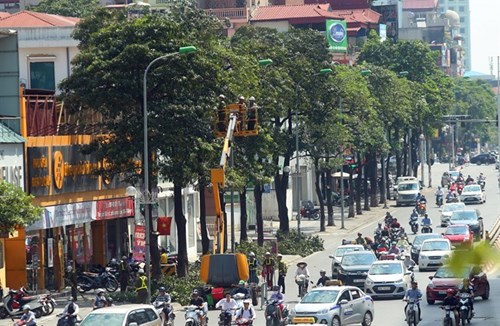Good air quality was recorded at the end of April and the beginning of May at monitoring stations in the districts of Cau Giay, Dong Da and Hoang Mai, according to the Hanoi Environmental Protection Agency.
    |
 |
|
Staff from the Hanoi Green Trees JSC take care of trees in the capital city. Growing more trees is one of the measures to improve the city’s air quality. (Photo for illustration) |
From 10 monitoring stations across the city, concentrations of harmful PM10 and PM2.5 matter decreased by 1.5 and 2 times respectively, compared to the period from November to December 2017.
The air quality index (AQI), which measures daily air pollution, saw a drastic improvement during the Reunification Day (April 30) and Labor Day (May 1) holidays, as well as during Lunar New Year holiday (February 16-21) compared to regular days due to lower traffic in the city.
However, bad air quality was still recorded at monitoring points near major roads, especially on Minh Khai street (part of National Route 32) and from Pham Van Dong street to Thang Long Bridge.
Particulate matter concentrations in these areas sometimes exceeded the permitted level, while their AQI often remained around average.
Measurements of air pollution in a recent report from the Green Innovation and Development Center (GreenID), a Vietnamese not-for-profit organization, have also worried people. It categorized Hanoi’s air quality in the first three months of the year as “bad” for people’s health.
While the report somewhat reflects reality, officials from the Hanoi Environmental Protection Agency said that those measurements do not represent the entire city because they were recorded near the Lang Ha-De La Thanh intersection where there is always heavy traffic.
Air quality in Hanoi is not as bad as what was written in the report, they said, adding that Vietnam’s official method of measuring AQI (issued by the Ministry of Environment and Natural Resources) is different to GreenID’s which follows the US’s environmental standards.
Amidst worries about the city’s air quality, environmental experts said that the city should try harder to get its observation data as accurate as it can in order to make better forecasts.
Aware of this, Le Tuan Dinh, deputy director of the Hanoi Department of Environment and Natural Resources, said that 70 more air monitoring stations will be installed across the city in the coming time.
“The city is applying several measures to improve its air quality, including reducing the number of motorbikes, limiting the use of honeycomb charcoal stoves for cooking, and growing more trees,” he said.
Nguyen Duc Chung, Chairman of the municipal People’s Committee on Monday, told the department to make public all information about the city’s air quality.
“We should keep people posted about the quality of air where they live on a daily basis, and highlight the reasons for it and solutions to improve it,” he said.
The capital city is going to hold a series of environmental protection activities in June in response to the Action Month on Environment and World Environment Day (June 5).
One notable event is a festival promoting sustainable living, which will take place on June 2 at Ly Thai To Park, near Hoan Kiem Lake.
Expected to attract 1,000 participants, it features games, exhibitions and activities that focus on promoting the use of environmentally friendly energy sources, recycling, waste collecting, and limiting plastic use.
On June 5, the municipal Department of Natural Resources and Environment will collaborate with the Vietnam Fatherland Front to clean up roads, drains and sewers in Tri Thuy commune in the city’s outer district of Phu Xuyen. About 500 participants are expected to take part in the activity.
Source: VNA